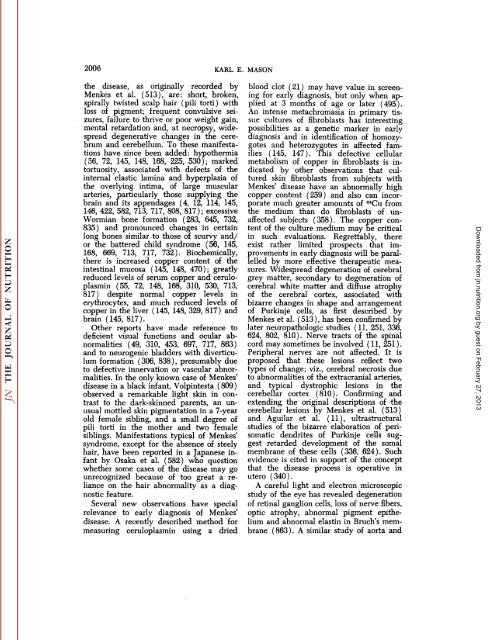conspectus of researchon copper metabolism and requirements
conspectus of researchon copper metabolism and requirements
conspectus of researchon copper metabolism and requirements
You also want an ePaper? Increase the reach of your titles
YUMPU automatically turns print PDFs into web optimized ePapers that Google loves.
2006 KARL E. MASON<br />
the disease, as originally recorded by<br />
Menkes et al. (513), are: short, broken,<br />
spirally twisted scalp hair (pili torti) with<br />
loss <strong>of</strong> pigment; frequent convulsive sei<br />
zures, failure to thrive or poor weight gain,<br />
mental retardation <strong>and</strong>, at necropsy, wide<br />
spread degenerative changes in the cere<br />
brum <strong>and</strong> cerebellum. To these manifesta<br />
tions have since been added: hypothermia<br />
(56, 72, 145, 148, 168, 225, 530); marked<br />
tortuosity, associated with defects <strong>of</strong> the<br />
internal elastic lamina <strong>and</strong> hyperplasia <strong>of</strong><br />
the overlying intima, <strong>of</strong> large muscular<br />
arteries, particularly those supplying the<br />
brain <strong>and</strong> its appendages (4, 12, 114, 145,<br />
146, 422, 582, 713, 717, 808, 817); excessive<br />
Wormian bone formation (283, 645, 732,<br />
835) <strong>and</strong> pronounced changes in certain<br />
long bones similar to those <strong>of</strong> scurvy <strong>and</strong>/<br />
or the battered child syndrome (56, 145,<br />
168, 669, 713, 717, 732). Biochemically,<br />
there is increased <strong>copper</strong> content <strong>of</strong> the<br />
intestinal mucosa ( 145, 148, 470 ) ; greatly<br />
reduced levels <strong>of</strong> serum <strong>copper</strong> <strong>and</strong> ceruloplasmin<br />
(55, 72, 148, 168, 310, 530, 713,<br />
817) despite normal <strong>copper</strong> levels in<br />
erythrocytes, <strong>and</strong> much reduced levels <strong>of</strong><br />
<strong>copper</strong> in the liver ( 145, 148, 329, 817) <strong>and</strong><br />
brain (145, 817).<br />
Other reports have made reference to<br />
deficient visual functions <strong>and</strong> ocular ab<br />
normalities (49, 310, 453, 697, 717, 863)<br />
<strong>and</strong> to neurogenic bladders with diverticulum<br />
formation (306, 838), presumably due<br />
to defective innervation or vascular abnor<br />
malities. In the only known case <strong>of</strong> Menkes'<br />
disease in a black infant, Volpintesta (809 )<br />
observed a remarkable light skin in con<br />
trast to the dark-skinned parents, an un<br />
usual mottled skin pigmentation in a 7-year<br />
old female sibling, <strong>and</strong> a small degree <strong>of</strong><br />
pili torti in the mother <strong>and</strong> two female<br />
siblings. Manifestations typical <strong>of</strong> Menkes'<br />
syndrome, except for the absence <strong>of</strong> steely<br />
hair, have been reported in a Japanese in<br />
fant by Osaka et al. (582) who question<br />
whether some cases <strong>of</strong> the disease may go<br />
unrecognized because <strong>of</strong> too great a re<br />
liance on the hair abnormality as a diag<br />
nostic feature.<br />
Several new observations have special<br />
relevance to early diagnosis <strong>of</strong> Menkes'<br />
disease. A recently described method for<br />
measuring ceruloplasmin using a dried<br />
blood clot (21) may have value in screen<br />
ing for early diagnosis, but only when ap<br />
plied at 3 months <strong>of</strong> age or later (495).<br />
An intense metachromasia<br />
sue cultures <strong>of</strong> fibroblasts<br />
in primary tis<br />
has interesting<br />
possibilities as a genetic marker in early<br />
diagnosis <strong>and</strong> in identification <strong>of</strong> homozy<br />
gotes <strong>and</strong> hétérozygotes in affected fam<br />
ilies (145, 147). This defective cellular<br />
<strong>metabolism</strong><br />
dicated by<br />
<strong>of</strong> <strong>copper</strong> in fibroblasts is in<br />
other observations that cul<br />
tured skin fibroblasts from subjects<br />
Menkes' disease have an abnormally<br />
with<br />
high<br />
<strong>copper</strong> content (259) <strong>and</strong> also can incor<br />
porate much greater amounts <strong>of</strong> 84Cu from<br />
the medium than do fibroblasts <strong>of</strong> un<br />
affected subjects (358). The <strong>copper</strong> con<br />
tent <strong>of</strong> the culture medium may be critical<br />
in such evaluations. Regrettably, there<br />
exist rather limited prospects that im<br />
provements in early diagnosis will be paral<br />
lelled by more effective therapeutic mea<br />
sures. Widespread degeneration <strong>of</strong> cerebral<br />
grey matter, secondary to degeneration <strong>of</strong><br />
cerebral white matter <strong>and</strong> diffuse atrophy<br />
<strong>of</strong> the cerebral cortex, associated with<br />
bizarre changes in shape <strong>and</strong> arrangement<br />
<strong>of</strong> Purkinje cells, as first described by<br />
Menkes et al. (513), has been confirmed by<br />
later neuropathologic studies ( 11, 251, 336,<br />
624, 802, 810). Nerve tracts <strong>of</strong> the spinal<br />
cord may sometimes be involved (11, 251).<br />
Peripheral nerves are not affected. It is<br />
proposed that these lesions reflect two<br />
types <strong>of</strong> change; viz., cerebral necrosis due<br />
to abnormalities <strong>of</strong> the extracranial arteries,<br />
<strong>and</strong> typical dystrophic lesions in the<br />
cerebellar cortex (810). Confirming <strong>and</strong><br />
extending the original descriptions <strong>of</strong> the<br />
cerebellar lesions by Menkes et al. (513)<br />
<strong>and</strong> Aguilar et al. (Il), ultrastructural<br />
studies <strong>of</strong> the bizarre elaboration <strong>of</strong> perisomatic<br />
dendrites <strong>of</strong> Purkinje cells sug<br />
gest retarded development <strong>of</strong> the somal<br />
membrane <strong>of</strong> these cells (336, 624). Such<br />
evidence is cited in support <strong>of</strong> the concept<br />
that the disease process is operative in<br />
utero (340).<br />
A careful light <strong>and</strong> electron microscopic<br />
study <strong>of</strong> the eye has revealed degeneration<br />
<strong>of</strong> retinal ganglion cells, loss <strong>of</strong> nerve fibers,<br />
optic atrophy, abnormal pigment epithe<br />
lium <strong>and</strong> abnormal elastin in Bruch's mem<br />
brane (863). A similar study <strong>of</strong> aorta <strong>and</strong><br />
Downloaded from<br />
jn.nutrition.org<br />
by guest on February 27, 2013
















